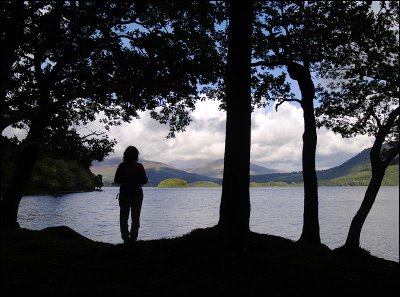Circus performers and dancers would stand naked without the example of Jules Leotard. Deprived of James Watt's watt what would scientists do? Or lorry drivers without Rudolph Diesel's engine? How would we describe temperature without Anders Celsius and Gabriel Fahrenheit? With a lot less confusion I hear you say! Charles Boycott, however, wouldn't be too pleased to find his name in common use, and many would wish that Henry Shrapnel had kept his invention to himself.
If you think all this a little "Kafkaesque" as an introduction to a silhouette photograph of my wife standing on the shore of Derwent Water in the English Lake District, then let me tell you that the word "silhouette" is an eponym too, and that fact prompted this piece! Louis XV's finance minister, one Etienne de Silhouette (1709-1767), became known during his retirement for cutting paper silhouettes of people, animals and objects. In the days before photography this practice, using a bright light source and black paper, was a simple and popular way of recording a likeness.
I had no such intention when I composed the image here - I was thinking of Japanes art rather than the French Renaissance. The early morning shadows and the fretwork outlines of the trees offered a delicate frieze and an interesting frame for the sunlit lake and mountains. The addition of a human figure was essential, giving the composition a necessary focus: the image would be much less without it. I made the camera expose for the background, and the foreground came out pretty much as you see it. A touch of masking and curves increased the contrast and brightness of the glimpsed vista. One thing that I would do differently, if I took the shot again, is to ensure that the summit of the central peak could be seen!
photograph & text (c) T. Boughen
